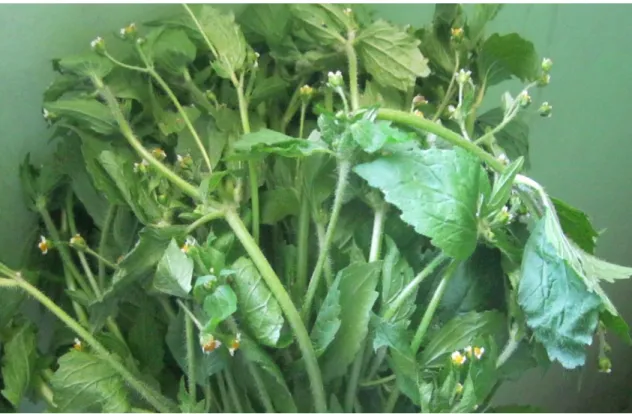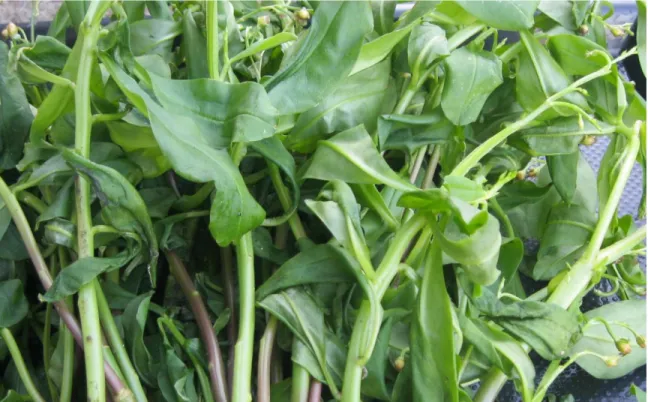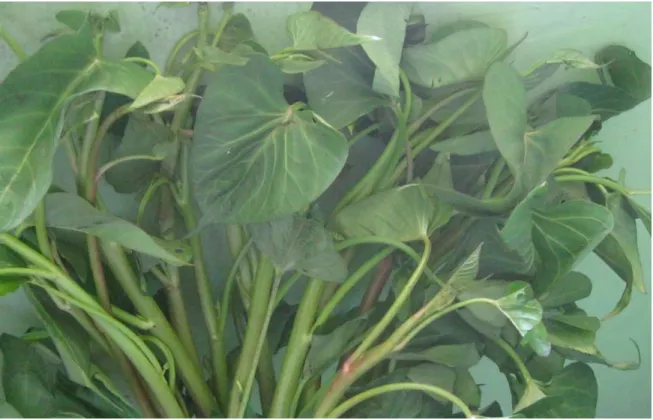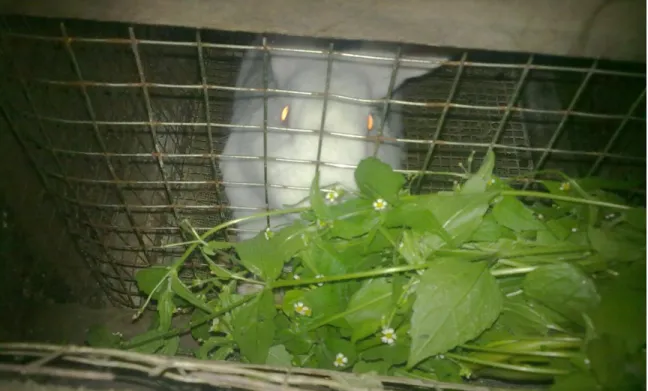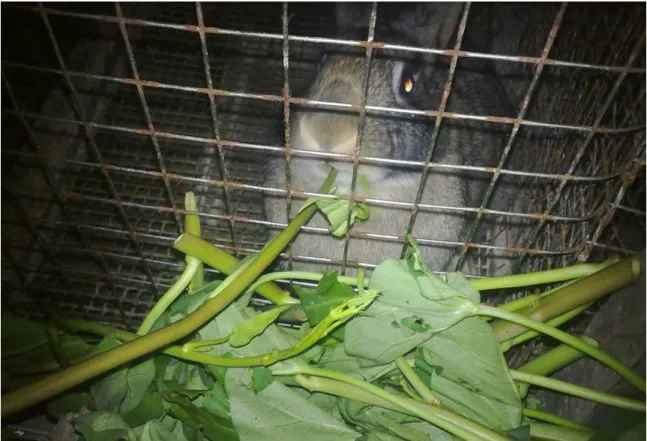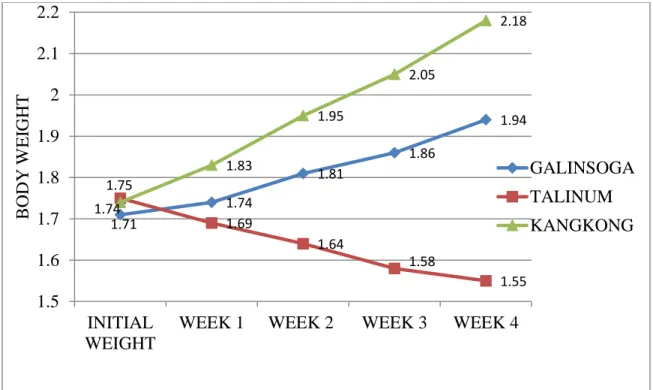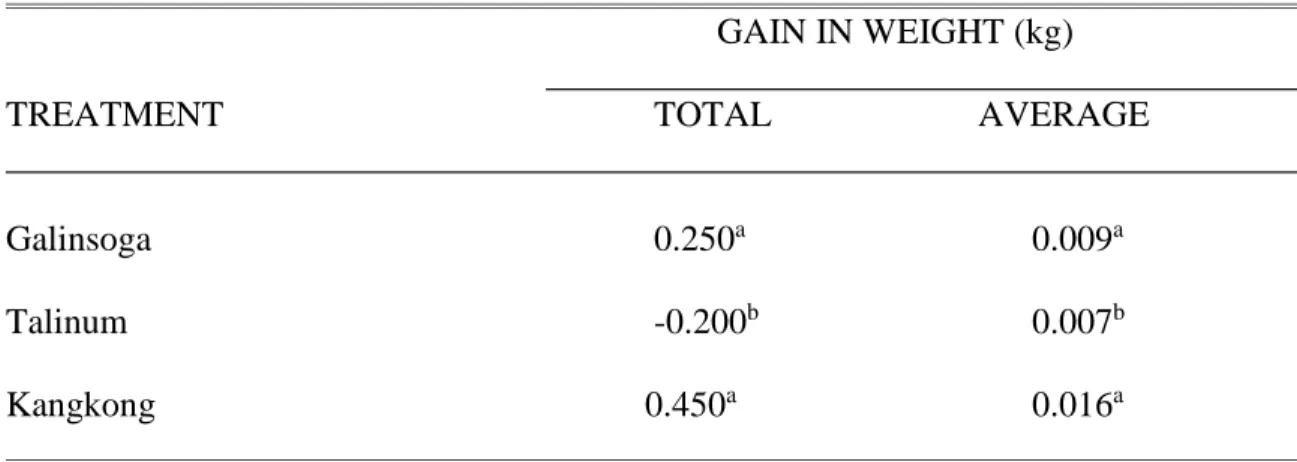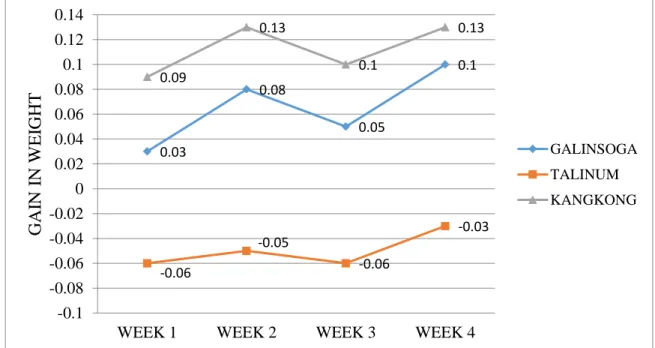BIBLIOGRAPHY
QUINTOS, JERLYN K. APRIL 2012. Growth Performance of Rabbits Fed with Galinsoga, Talinum and Kangkong. Benguet State University, La Trinidad, Benguet.
Adviser: Sonwright B. Maddul, Ph.D.
ABSTRACT
The study was conducted at the Animal Genetic Resources (TANGERE) Project, Bektey, Puguis, La Trinidad, Benguet to determine growth performance of rabbits fed with galinsoga, talinum, and kangkong; to determine which local feedstuffs are preferred by rabbits; determine the effect of galinsoga, talinum and kangkong on the gain in weight of rabbits; and to determine the feed conversion ratio in rabbits given galinsoga, talinum and kangkong.
The different treatments were T1 (Galinsoga), T2 (Talinum) and T3 (Kangkong).
Basing on the result of the study kangkong and galinsoga are better than talinum in terms of gain in weight and feed conversion ratio.
With the result of the study, kangkong and galinsoga is recommended as basal diet to rabbits.
INTRODUCTION
Rabbit production is becoming popular because of its importance to most Filipinos.
It provides meat which is a good source of protein and has a lower fat content compared to pork and beef. Therefore it is very important especially to children who are malnourished.
The skin is also processed into pelt which are trimmed after tanning, cut and sold into novelty articles like bags, shoes etc. They are also sown together for coats, blankets and upholstery. Rabbit manure can also be utilized as fertilizer.
According to Maddul (2002) rabbit manure has 2.45% nitrogen and 1.3 % phosphoric acid which are relatively higher than those other animal manures. Their potash content of 0.6 % is comparable with those of other animals except goat and sheep.
Furthermore, he stated that rabbit manure is not hot during decomposition. Thus, it is only animal manure that does not burn plants. It was calculated that 15 does, two bucks and their litters will produce approximately one ton of rabbit manure in one year therefore, rabbit manure is an excellent fertilizer for vegetables.
Since almost all the parts of the rabbit including its waste products are useful and important to human beings, rabbit production provides an excellent source of income.
However, there are some factors that affect rabbit production and adaptability. These factors include lack of capital, stock availability, stock adaptability to local conditions, care and management and high cost of feeds which is true not only for rabbits but also for other animals.
The high cost of feeds has prompted many small farm rabbit raisers to variouspractices to reduce their feed expenses. The usual practice of rabbit raisers is to use commercial feeds like swine grower ration which accounts for a large percentage of total production cost. Rabbits are not difficult to provide feed, they can consume roughages, but these feeds are normally seasonal. In order to sustain growth rate throughout the year alternative resources of feeds must be sought particularly during dry season.
One way to minimize feed cost is introducing feedstuffs which are locally found forages like galinsoga, talinum, kangkong and malunggay.
Result of this study could contribute knowledge to students especially to animal science and veterinary students. It will also serve as additional information on feeds and feeding and animal nutrition. It will also help farmers or backyard raisers on what leaves are to be fed to their rabbits that may contain high nutritive value that is available in the locality and to be able to help reduce the high cost of feeds.
In addition, it can help vegetable farmers because they can utilize the galinsoga weeds which compete on growing crops as feeds to their rabbits as long as it did not absorb chemicals and also to utilize the leaves ofmalunggay, talinum and kangkong.
The general objective of the study is to determine the preference and growth performance of rabbits fed with galinsoga, talinum, and kangkong.
Specifically this study aimed to:
1. determine which local feedstuffs are preferred by rabbits;
2. determine the effect of galinsoga, talinum and kangkong on the gain in weight of rabbits; and
3. determine the feed conversion ratio in rabbits given galinsoga, talinum and kangkong.
The study was conducted at the Animal Genetic Resources (TANGERE) Project at Bektey, Puguis, La Trinidad, Benguet from November to December 2011.
REVIEW OF LITERATURE
In agriculture, fodder or animal feeds is any feedstuff that is used specifically to feed domesticated livestock such as cattle, goats, sheep, horses, chickens, rabbits and pigs.
It includes hay, straw, silage, compressed and pellet feeds oils and mixed rations, and also sprouted grains and legumes. Most animal feeds are coming from plants like fodder tree leaves such as malunggay. Herbs are also being given to animals as feeds. It is a garden plant that are grown and harvested for culinary, aromatic and medicinal uses.
Ando et al., (2001) reported that when dried herbs were fed to lactating cows, the characteristic smell of cow milk was suppressed due to the transmission of components peculiar to such herbs into cows. Their study demonstrated that milk flavor could be controlled by the use of herbs as a feed supplement for dairy cows. Moreover, herb feeding to cattle is possible beneficial for the welfare of the animals and decrease stress for them.
Utilization of Galinsoga Leaves
Galinsoga parviflora is an annual dicot species of the family Asteraceae, is a common herb that is often found in disturbed habitats and agricultural areas in many parts of the temperate and subtropical regions of the world. Galinsoga parviflora is considered to be a common weed in several crops of major importance, such as wheat, corn, cotton, tobacco, sugar beet, tomato, pepper, potato, bean, onion, cabbage and others. It is frequentlyfoundingardensand uncultivated areas. Galinsoga parviflora competes strongly, particularly with irrigated crops of short height, and it might also hinder crop harvest (Damalas, 2008).
Grubben et al., (2004) stated that Galinsoga parviflora contains 88.4 g water, 653 KJ energy, 3.2g protein, 0.4g fat, 5.2g carbohydrates, and 1.1g fiber for every 100 g of its edible portion.
According to Ayeni (2000) farmers in Africa believe that Galinsoga plant enhances milk production when fed to dairy cattle.
Utilization of Talinum Leaves
Waterleaf (Talinum triangulare) is a non-conventional vegetable crop of the Portulacea family which originated from tropical Africa and is widely grown in West Africa, Asia, and South America (Schippers, 2000 as cited by Enete and Ukon, 2010).
The plant contains cardioglycosides, flavonoids and polyphenols. The moisture content of the plant is 90.8%. It contains 2.4, 0.4, 4.4 g kg-1 of proteins, total fats and total carbohydrate, respectively (Fasuyi, 2006).
T. triangulare is edible and has nutritive value (Folarin et al., 2001). There are claims that the plant also possesses medicinal value. It has been credited with curing of internal heat, measles and some sexually transmitted diseases. It has prooxidant activity (Iwalewa et al., 2005) and anti-inflammatory effect (Oluwole, 2003).
Ekpo et al., (2007) found out on their study on the Biochemical Effects of Talinum triangulare in Rat that the extract of T. triangulare possesses hemolytic and hyperglycemic effects, suggesting that it may not be safe for a diabetic patient to consume the plant without medical supervision.
Saidu and Sideobi (2009) found out on their study that among the four leafy vegetables, talinum ,vernoma, moringa and telfeira, Talinum triangulare has the highest moisture content which might be due to large number of cell saps they possess, vernoma had the highest ash and lipid content (2.5 and 0.70% respectively), moringa had the highest amount of protein (29%). It is the richest source of sodium. The result obtained indicates that the four leafy vegetables are cheap and readily available as source of nutrients.
Irvine (2001) reported that in Africa, Talinum triagulare is given to fowls to stimulate egg laying.
According to Iheukwumere (2008), the average litter sizes at birth weaning weight were similar (P > 0.05) between 40:60 and 60:40 (concentrate and Talinum triangulare) combinations but, they differed significantly (P < 0.05) from 20:80 and 80:20 concentrate and forage combinations. However, 20:80 diets differed significantly (P < 0.05) from 80:20 diet combinations. In terms of average litter weight gain the combination of 60%
concentrate + 40%Talinum triangulare attained the highest followed by 80:20 concentrate and Talinum triangulare. He therefore concluded that even though 40:60 concentrate and forage combination diets were similar in all traits determined, however, 60:40 combinations diets showed higher values on litter sizes, litter weight at weaning and mortality.
Utilization of Kangkong Leaves
Water spinach (Ipomoea aquatica) is a vegetable that is consumed by people and animals; it has a short growth period, is resistant to common insect pests and can be cultivated either in dry or flooded soils. Moreover, it has been found that water spinach
has a high potential to convert nitrogen from bio digester effluent into edible biomass with high protein content (Sophea and Preston 2001).
Ipomoea aquatica, a commonly grown green leafy vegetable is a rich source of vitamins, minerals, proteins, fibers, carotenes and flavonoids with many health benefits (Prasad et al., 2008). Water spinach has the potential to play an important role for farmers and animas in rural areas, because it is easy to plant and has a very high yield of biomass, which is rich in protein. The crude protein content in the leaves and stems can be as high as 32 and 18 % in dry basis, respectively (Luyen and Preston 2004).
Samkol et al., (2006) reported that in their study conducted at Phnom Phen, Cambodia aim the effect of increasing of water spinach (Ipomoea aquatica) on intake growth and digestibility coefficient of rabbits, that a fresh water spinach as the sole of rabbits can support acceptable growth rate of 14 to 20 g/day with dry matter feed convention between 3.83 and 5.18. In addition, they stated that increasing the offer level of water spinach from 8% to 18% of live weight (DM basis) increased the proportion of leaf consumed, the intake of crude protein and the digestibility of the DM and the crude protein. However, live weight gain was depressed with increasing offer level apparently because of a decrease in the crude fiber content of the diet, as with, increasing offer level the rabbits selected “low fiber” leaves rather than “high fiber” stems.
According to Phiny and Kaensombath (2006), supplementing fresh water spinach with rice bran appeared no benefit in terms of rate of growth and feed consumption in growing rabbits.
Providing supplements rich in fibre improved rabbits growth rate in basal water spinach diets (Hue and Preston, 2006; Gang et al., 2006)
According to Tam et al., (2006), rate of live weight gain increases when leaves of cauliflower, cabbage and chinese cabbage were offered in addition to the basal diet of water spinach. Further they stated that a supplement of paddy rice stimulated feed intake and growth rate of rabbits fed with cabbage + water spinach, cauliflower + water spinach, chinese cabbage + water spinach, water spinach alone and all the vegetable wastes with paddy rice diets.
According to Nguyen Van and Nguyen Thi (2008), reported that the daily gain was significantly higher in the water spinach diet that is 17.7 g/day than the sweet potato vine (SP), water spinach + mom grass (WS+M), water spinach + Cuc (wedelia spp.), sweet potato vine + mom grass (SP+M), and sweet potato vine +Cuc (SP+C) which is 15.8, 15.0, 15.2, 14.2, and 14.4 respectively. Furthermore they observed that daily gain is the same with feed conversion ratio (DM basis), water spinach had the lowest that is 3.35 which is an indication of good efficiency while the other diet in the same order are 3.91, 4.34, 4.19, 4.5 and 4.39. they observed that feed conversion ratio of the two sigle forage diets( water spinach and sweet potato vine) were significantly difference (P<0.05) lower than the other diets involving two forages. However, they found out sweet potato + mom grass and sweet potato + Cuc diets have the higher financial benefits.
Kim Dong et al., (2008) found out that final live weight and daily gain of rabbit is higher when fed 50% and 75% water spinach leaves compared to rabbits fed with para grass alone and 25% water spinach leaves. Furthermore, they stated that feed conversion ratio was poorest for animals fed with Para grass alone and improved (P<0.01) with
inclusion level of water spinach and increasing levels of water spinach leaves in the diets of growing crossbreed rabbits, increase feed utilization and growth rate. Therefore, it was concluded that levels from 50% to 75% of water spinach leaves supplemented to para grass diets give higher economic benefits for small farmers.
Utilization of Malunggay Leaves
According to Pati (2006), based on analysis on a per 100 grams leaves of malunggay, it contain 75% of moisture, 92% calorie, 6.7g protein, 1.7g fat, 13.4g
Carbohydrates, 0.9g fiber, 2.3g minerals.
Based on the result of the study conducted in Tanzania on the effect of Moringa oleifera leaf meal as substitute for sunflower seed meal on performance of laying hens, the laying percentage is decreasing slightly with an increase of Moringa oleifera proportion in the diet while in terms of egg weight, birds fed with diet containing 5% Moringa oleifera leaf meal is the highest and the birds fed with diet containing 20% MOLM in the diet is the lowest (Kakengi et al., 2007).
The result of the study showed that multi-nutrients blocks had a high value of protein which is 37.4% compared to Moringa oleifera which is 26.37%. Moringa oleifera was richer in cellulose (19.16%) than multi-nutrients (4.76%). No significant difference (P>0.05) was observed between weights of the females before birth. The weight of the young group supplemented with multi-nutrients blocks was statistically higher (P>0.05) than those of the other groups. (Tedonkeng et al., 2005).
According to Murro et al., (2003) in their study on Moringa oleifera leaf meal can replace cottonseed cake in the concentrate mix fed with Rhodes grass (Chlorisgayana) hay for growing sheep, reported that the dry matter digestibility and live weight gain
were higher, but feed conversion rations were poor when Moringa oleifera leaf meal replaced all the cotton seed cake. Based on the result of the study, it was concluded that Moringa oliefera leaf meal could serve as an alternative protein source to cottonseed cake in sheep rations based on maize bran and Rhodes grass hay.
MATERIALS AND METHODS Materials
The materials that were used in the experiment were the following: 24 rabbits (Chinchilla and New Zealand White) at 4 months old, hutches, weighing scale, cages, crocks for drinking water, record book and different forages tested.
Methods
The study involved two experiments:
1. Palatability trial in which leaves (galinsoga, kangkong, malunggay, and talinum) was offered separately to experimental rabbits in order to determine the top three leaves which are preferred most by the rabbits in terms of intake.
2. Feeding trial in which at least three feedstuffs from those tested for palatability were further evaluated for growth performance of rabbits. The feeding trial lasted for 28 days using the 12 male rabbits offered previously with the selected feedstuffs.
Experiment 1. Palatability Trial
Twenty four rabbits were used in the experiment. Four different leaves including the stalk and petiole were offered fresh separately to each experimental rabbits to determine which plant part rabbit’s preferred most. The four feedstuffs were harvested every other day from several sources: talinum, kangkong and malunggay from Tayug, Pangasinan and Galinsoga were harvested from La Trinidad, Benguet. Kangkong and Talinum were subjected for air drying while malunggay were offered fresh. As much as possible the feedstuffs were taken from the same variety of plants to minimize source ofvariation.
About 300 g of each feedstuff were offered per day following the Completely
Randomized Design of an experiment. There were six replication with one rabbit serving as a replicate.
The following treatments are as follows:
T1= Galinsoga (Galinsoga parviflora) T2=Kangkong (Ipomoea aquatica) T3=Talinum (Talinum triangulare) T4=Malunggay (Moringa oleifera)
Experiment 2. Feeding Trial
From the result of the palatability the top three feedstuffs in terms of high acceptance level were selected for performance evaluation. The three feedstuffs served as treatments such as galinsoga, talinum and kangkong that were replicated four times. The feedstuffs used for dietary treatments are shown in Figures 1-3.
Figure 1. Diet 1 (Galinsoga parviflora)
13
Figure 2. Diet 2 (Talinum triangulare)
Figure 3. Diet 3 (Ipomoea aquatica)
The Completely Randomized Design of an experiment was used. A total of 12 male experimental rabbits are involved using the same animals that consumed the selected feedstuffs in the previous experiment.
T1= Galinsoga (Galinsoga parviflora) T2= Talinum (Talinum triangulare) T3= Kangkong (Ipomoea aquatica)
To lessen variation, the test foliage was obtained from the same source or origin.
Body weight was measured at the start of the experiment and at the end of the experiment.
Weekly weight was also measured.
Figures 4 and 5 represent the experimental rabbits consuming the feedstuffs. Each rabbit was fed twice a day with 300g of feedstuffs at 7: 30 am and 4: 30 pm. Water was available at all time in an earthen jar.
Data Gathering and Analysis
The following data were gathered:
1. Initial weight (kg). This was the individual weight of the rabbits at the start of the feeding trial.
2. Weekly weight (kg). The body weight of the experimental rabbits was measured on a weekly basis.
3. Final weight (kg). This was the body weight of the rabbits taken at the end of the feeding trial.
Figure 4. Rabbits fed with galinsoga
Figure 5. Rabbits fed with kangkong
4. Amount of feed offered (kg). The amount of daily feed offered was recorded for each replicate.
5. Amount of feed left over (g). Daily amount of feed not consumed by the rabbits will be recorded for each replicate.
From the data gathered the following parameters were computed.
1. Total gain in weight (kg). This was the difference between the final and the initial weight.
2. Average daily gain (kg). It was computed as:
Average Daily Gain= Total Gain in Weight Duration of the Experiment 3. Weekly gain in weight (kg). It was computed as:
Total Weekly Gain in Weight= Weekly Weight –Initial Weight
4. Total feed consumption (kg). This was obtained by using the formula:
Total feed Consumption= Total Feed Offered – Total Feed Left over 5. Feed conversion ratio. It was computed as:
Feed Conversion Ratio = Total Feed Consumption Total Gain in Weight Statistical Analysis of Data
All the data were subjected to Analysis of Variance (ANOVA) for a Completely Randomized Design (CRD) experiment. Duncan’s Multiple Range Test (DMRT) was used to compare treatment means.
RESULTS AND DISCUSSION Body Weight of the Experimental Rabbits
The average initial,weekly weight and final weight of the rabbits in the different treatments during the start and at the end of the study is shown in Figure 6.
Initial and final weight of the experimental animals was taken when they were approximately 4 months old and 5 months old of age, respectively.The body weight of the experimental rabbits was measured on a weekly basis.
Statistical analysis revealed no significant differences among treatments in the mean initial weight. This conforms to the requirement of the experimental design that experimental units should be similar in properties such as initial weight.
Rabbits fed with galinsoga, had the mean initial weight of 1.71 kg. Rabbits fed with talinum had the mean initial weight of 1.75 kg and those fed with kangkong registered the mean initial weight of 1.74 kg.
While the experimental rabbits started with the same initial weight, the animals finished the feeding trial with different final weight. Rabbits given kangkong, obtained the highest final weight of 2.18 kg followed by rabbits receiving galinsoga with the mean final weight of 1.96 kg. Rabbits fed with talinum had the lowest final weight of 1.55 kg.
Figure 6 also shows the increase in body weight of the experimental rabbits weekly.
The initial weight of the rabbits are almost similar from each other however, at the end of the experiment they have different final weight. It could be seen in the figure that rabbits fed with kangkong attained the highest final weight also it was observed to have the highest increasing weekly gain in weight followed by the rabbits fed with
Figure 6. Mean body weight of the experimental rabbits
galinsoga. Rabbits fed with Talinum have the least wherein the entire weekly weight of the animals’ decreases. This result may be affected by the tannin and saponin content of which can harm the animal. (Aja et al., 2010). Another possible reason is that talinum absorbs all types of metals where it is planted including arsenic (Aligui, 2010).
Statistical analysis shows differences among treatment means were not significant in the first, second, and third week of the mean weekly weight while it revealed a highly significant difference in the fourth week or the mean final weight. Further, DMRT analysis revealed no significant differences between the rabbits fed galinsoga from those fed kangkong in the final weight. This means that weekly weight in week 1, 2 and 3 of the rabbits in the different treatment is more or less the same.
1.71
1.74
1.81
1.86
1.94
1.75
1.69
1.64
1.58
1.55 1.74
1.83
1.95
2.05
2.18
1.5 1.6 1.7 1.8 1.9 2 2.1 2.2
INITIAL WEIGHT
WEEK 1 WEEK 2 WEEK 3 WEEK 4
BODY WEIGHT
GALINSOGA TALINUM KANGKONG
Results of the study are similar to the report of Kim Dong N.T.et al., (2008) where the final weight and the average daily gain of the animals is significantly higher when growing rabbits are fed with water spinach.
Gain in Weight of Experimental Rabbits
Table 1 shows the total gain in weight and average daily gain in weight of the experimental rabbits.
Statistical analysis revealed that differences among treatment means were highly significant in both total gain in weight and average gain in weight. This means that the total gain in weight and the average daily gain in weight are not homogenous.
Rabbits fed with kangkong had the highest total gain in weight and an average daily gain in weight of 0.45 kg and 0.016 kg, respectively; followed by rabbits fed with galinsoga with the total gain in weight of 0.25 kg and an average daily gain in weight of 0.009 kg.
The result of the study is similar to the finding of Kim Dong et al., (2008) where in when rabbits fed with kangkong the final weight and the daily gain of rabbits increases. Average daily gain of rabbits fed with kangkong which is 0.01607 kg or 16.07 g/day is within the range of the results observed by Phimmasan et al., (2004), Samkol et al., (2006) and Phiny and Kaensombath (2006) in which water spinach, a local forage source was used as the sole diet of growing rabbits with supporting growth rates of 15 to 20 g/day. However, the values are higher than those found by Tam et al., (2009) which is 13.7 g/day.
Results are the same with the findings of Nguyen Chu et al., (2003) as cited by Nguyen Van and Nguyen Thi (2008)where in higher growth rate of rabbits occurred when animals were fed with water spinach alone. It is also similar to the report of Phiny
Table 1. Mean gain in weight of the experimental rabbits
GAIN IN WEIGHT (kg)
TREATMENT TOTAL AVERAGE
Galinsoga 0.250a 0.009a
Talinum -0.200b 0.007b Kangkong 0.450a 0.016a Means with the same letter are not significantly different at 0.05% DMRT level.
and Kaensombath (2006) that supplementing fresh water spinach with rice bran appeared to confer no benefits in terms of rate of growth and feed conversion in growing rabbits.
It is also similar with the findings of Phimmasan .et al., (2004) and Samkol et al., 2006) that there had no response even higher energy density such as broken rice will be supplemented. However providing supplements rich in fibre, improved rabbit growth rate (Hue and Preston, 2006 and Gang et al., (2006). Water spinach supplemented with concentrates, the growth rate exceeds at 30 g/day in the study of Chat et al., (2005).
This implies that rabbits fed with kangkong had a better growth performance. The animals utilized the nutrients present in the water spinach like amino acids, vitamins and minerals leading to a high average daily gain and total gain in weight.
Rabbits fed with talinum had decreased in weight resulting to a negative total gain in weight of -0.20 kg and an average gain in weight of -0.007 kg. Results may be because rabbits on talinum diet had a lesser feed consumption and it does not meet the nutrient requirement of the animal. Possible reasons of loss in weight of the animal can be due to the alkaloids, flavonoids, saponins and tannins contents of the forage which can affect the
palatability of the animal (Aja et al., 2010). Some of these analyse constituents of the vegetables species maybe completely harmful in both man and farm animals (Aja et al., 2010). Another possible reason is the source of the forage because talinum absorbs all types of metals where it is planted including arsenic (Aligui, 2010).
The weekly increase in the weight of rabbits is shown in Figure 7. It could be seen in the data that the highest increase in weight was obtained by rabbits fed with kangkong on the first, second and fourth week but not on thethird.Graph of gain in weight of rabbits fed with kangkong is similar to galinsoga and talinum. They decrease in weight during the third week and it increased in the final weight. Possible reasons of decreasing weight during the third week may had affected by high feed left over resulting to a lower intake and it was observed that mostly of the feed left over are hard stems. Another possible reason is the time of feeding the animal.
Figure 7.Weekly gain in weight of experimental rabbits
0.03
0.08
0.05
0.1
-0.06
-0.05
-0.06
-0.03 0.09
0.13
0.1
0.13
-0.1 -0.08 -0.06 -0.04 -0.02 0 0.02 0.04 0.06 0.08 0.1 0.12 0.14
WEEK 1 WEEK 2 WEEK 3 WEEK 4
GAIN IN WEIGHT
GALINSOGA TALINUM KANGKONG
Statistical analysis revealed highly significant difference among treatment means in the fourth weekly gain in weight while significant differences among treatment means was observed in the first, second and third weekly gain in weight.
The results shows that rabbits fed with kangkong have grown faster than the rabbits fed with galinsoga and talinum however; statistical analysis shows that galinsoga and kangkong are not significantly different between treatment means.
Feed Consumption of Experimental Rabbits
The total feed consumption and the mean daily feed intake by the experimental rabbits is presented in Table 2.
Results of the statistical analysis revealed a highly significant difference observed in both total feed consumption and average feed intake of the experimental animals. It is shown in the table that higher feed consumption was observed from the rabbits fed with galinsoga of a total feed consumption and an average daily feed intake of 24.33 kg and 0.87 kg respectively, followed by rabbits given kangkong with a total feed consumption of 23.60 kg and an average daily feed intake of 0.87 kg per day. Rabbits receiving talinum consumed the least amount of feeds with the total feed consumption of 10.96 kg and an average daily feed intake of 0.39 kg per day. Possible reasons of less feed intake of the experimental animals might affected by the tannin and saponin content of the forage where in it may harm the animal (Aja et al., 2010). Another reason might be also the source of the feedstuff.
Table 2. Mean feed consumption of experimental rabbits
FEED INTAKE (kg) TREATMENT TOTAL DAILY
Galinsoga 24.33a 0.87a
Talinum 10.96b 0.39b
Kangkong 23.60a 0.84a
Means with the same letter are not significantly different at 0.05% DMRT level
Comparisons of means showed that rabbits fed with galinsoga did not differ from the rabbits receiving kangkong. However, rabbits fed with talinum are significantly different to those given galinsoga and kangkong.
Results may have affected the gain in weight of the animals. Table 2 shows that rabbits fed with galinsoga and kangkong had the highest feed intake while those given talinum had the lowest feed intake. Table 1 also shows the same where rabbits given galinsoga and kangkong had the highest gain in weight and those rabbits given talinum had the lowest gain in weight. There might be reasons affecting the gain in weight of the animals and feed consumption was one possible reason such as rabbits fed with kangkong had the higher gain in weight than those given talinum because rabbits fed with kangkong and galinsoga has higher feed intake than rabbits given talinum.
Feed Efficiency of Experimental Rabbits
Table 3 presents the feed conversion ratio of the experimental rabbits in the different treatments.
Table 3. Feed conversion ratio as affected by feedstuffs
TREATMENT MEAN
Galinsoga 65.06a
Talinum -94.42b
Kangkong 119.34a
Means with the same letter are not significantly different at 0.05% DMRT level
Feed conversion ratio is a measure of the efficiency of converting feed input into productive output. It represents the feed consumed per unit of body gain. Higher numerical values are indication of poor feed efficiency since it means more feed is needed to every unit gain. On the other hand, lower feed conversion ratio signifies better feed efficiency.
Statistical analysis revealed that differences among treatment means were highly significant. Furthermore DMRT analysis revealed that there were no significant differences among treatment means between rabbits fed with galinsoga and kangkong.
Better feed conversion ratio was registered by rabbits fed with kangkong with a mean of 65.06 followed by rabbits fed with galinsoga of 119.34. Results of the study are similar with the findings of Hue and Preston (2006) where in feed conversion ratio of the rabbits feed with water spinach is low which signifies a good feed efficiency.This means that rabbits fed with galinsoga had consumed greater amount of feed to produce a kilogram
gain in weight and this resulted in a higher feed conversion ratio. From the computed feed conversion ratio rabbits given galinsoga and kankong should consume 119.34 kg of galinsoga and 65.06 kg respectively in order to gain 1 kg of body weight.
Rabbits fed with talinum have loss in weight as observed in Table 1 which resulted to a negative feed conversion ratio.
SUMMARY, CONCLUSION AND RECOMMENDATION Summary
The study on the growth performance of rabbits fed with Galinsoga, Talinum and Kangkong was conducted at the animal Genetic Resources (TANGERE) project at Bektey, Puguis, La Trinidad Benguet from November to December 2011. The study aimed to determine the feed preference and growth performance of rabbits fed galinsoga, talinum and kangkong. It was also conducted to determine which local feedstuffs are preferred by rabbits, to determine the effect of galinsoga, talinum and kangkong on the gain in weight of rabbits and to determine the feed conversion ratio in rabbits given galinsoga, talinum and kangkong. There were twenty four rabbits (Chinchilla and New Zealand white) used in the study. The treatments used are the following; galinsoga (T1), Talinum (T2), kangkong (T3) and it was replicated four times following the Completely Randomized Design.
Results of the study showed that rabbits fed with kangkong obtained the highest final weight, total gain in weight, average daily gain, and feed efficiency moreover, feed consumption are lower than the rabbits fed with galinsoga. Statistical analysis revealed that there was a significant difference among the treatments on final weight, weekly gain in weight in week 1, week 2 and week 3 but not on initial weight, weekly weight in week 1, 2 and 3. On the other hand, highly significant differences was obtained among treatments means on total gain in weight, average gain in weight, feed intake, average feed intake, feed conversion ratio and weekly gain in weight in week 4.
Conclusion
Basing on the result of the study kangkong and galinsoga are better than talinum in terms of gain in weight and feed conversion ratio.
Recommendation
It is therefore recommended to use kangkong and galinsoga as basal diet to rabbits.
LITERATURE CITED
ALIGUI G. 2010.Talinum as an Ethnic Food with High Nutritional Value. Research Institute for Tropical Medicine. Retrieved March 10, 2012 from http://gonatural.com.ph/herbalblog/talinum-talinum-triangulare.
ANDO S., M. NISHIDA, M. ISHIDA, Y. KOCHI, A. KAMI, and S. SE. 2001.
Transmission of Herb Essential Oil to Milk and Change of Milk Flavor by Feeding Dried Herbs to Lactating Cows. Nippon Shokuhin. Kagaku Kaishi.48:142-145.
AJA P.M, A.N.C. OKAKA, P.N. ONU, U. IBIAM AND A.J. URAKO.
2010.Phytochemical Composition of Talinum triangulare (Water Leaf) Leaves.Pakistan Journal of Nutrition. Department of Biochemistry and Biotechnology, Department of Animal Science, Ebonyi State University, P.M.B.
053, Abakaliki, Ebonyi State, Nigeria.
AYENI, T. 2000. US/Africa collaborations: Recent Experiences at Rutgers School of Environment and Biological Sciences.
CHAT, T.H. N. T. DUNG, D. V. BINH AND T.R. PRESTON 2005. Water Spinach (Ipomoea aquatica) as Replacement for Guinea Grass for Growing and Lactating Rabbits. Livestock Research for Rural Development. Volume 17, Article #109.
Retrieved October 30, 2006 from
http://www.cipav.org.co/lrrd/lrrd17/10/chat17109.htm.
DAMALAS, C.A. 2008. Distribution Biology and Agricultural Importance of Galinsoga parviflora (Astracae).Weed Biology and Management. 8:147-153.
EKPO, O. ESEYIN, N. KALU, O. JACKSON AND E.J. EDOHO, 2007. Studies on the Biochemical Effects of Talinum triangulare in Rat. Journal of Pharmacology and Toxicology, 2: 300-303. http://scialert.net/fullte xt/?doi=jpt.2007. 300.303
&org=10.
ENETE, A.A. U.A.UKON. 2010. Economics of Waterleaf (Talinum Triangulare) Production in AkwaIbon State, Nigeria. The Journal of field action, Volume 4 Department of Agricultural Economics, University of Nigeria, Nsukka.
FASUYI, A.O., 2006. Nutritional Potentials of some Tropical Vegetable Leaf Meals:
Chemical Characterization and Functional Properties. Afr. J. Biotechnology., 5: 49- 53.
FOLARIN, O.M., F.O. BAMIRO AND K.O. ESUOSO, 2001. Distribution of Nutritive Elements in Water Leaf. Global J. Pure and Applied Sci., 7: 285-290
FOOD AND AGRICULTURAL ORGANIZATION, 2001. Grassland Index. A Searchable Catalogue of Grass and Forage Legumes. FAO.
GANG D, T., K.T, HUE D. V, BINH AND N. T. MUI . 2006. Effect of Guinea Grass on Feed Intake, Digestibility and Growth Performance of Rabbits fed a Molasses Block and either Water Spinach (Ipomoea aquatica) or Sweet Potato (Ipomoea batatas L) Vines. Workshop-seminar "Forages for Pigs and Rabbits" MEKARN- CelAgrid, Phnom Penh, Cambodia, 22-24 August, 2006. Article #23 RetrievedMarch 14, 112, from http://www.mekarn.org/proprf/gang.htm.
GRUBBEN, G.H, O.A DENTON, C.M. MESSIAEN and R.R. SCHIPPERS. 2004. Plant Resources of Tropical Africa, Volume 2: Vegetables. PROTH Foundation /Backhuys Publisher/CP. Wagenengen, Netherlands.
HUE, K,T. AND PRESTON T. R .2006. Effect of Different Sources of Supplementary fibre on Growth of Rabbits fed a Basal Diet of Fresh Water Spinach (Ipomoea aquatica). Livestock Research for Rural Development.Volume 18, Article #58.
Retrieved October 30, 2006 from
http://www.cipav.org.co/lrrd/lrrd18/4/hue18058.htm.
IHEUKWUMERE, F.C. 2008. Effect of Mixed Feeding Regime on Litter Performance Traits of Rabbit Does. Pakistan Journal of Nutrition Department of Animal Science and Fisheries, Abia State University, PMB 7010, Umuahia, Nigeria.
IWALEWA, E.O., C.O. ADEWUMI, N.A. OMISORE, O.A. ADEBIYI AND C.K. AZIKE 2005. Pro-and Anti-oxidant Effects and Cytoprotective Potentials of nine edible Vegetables in South West. Nig. J. Med. Food, 8: 539-544.
IRVINE, F.R. 2001. The Edible Cultivated and Semi-cultivated of West Africa. Plants, Food for Human Nutrition. Springer, Netherlands.
KAKENGI, A.M., J.T. KAUAGE, S.V. SARWATT, S.K, MUTAYOBA, M.N. SHEM, and T. FUJIHARA.2007. Effect of Moringa oleifera Leaf Meal as a Substitute for Sunflower Seed Meal on Performance of Laying Hens in Tanzania. Department of Animal Science and Production, Sokoine University of Agriculture, Box 3004,Morogoro – Tanzania Retrieved September 3, 2011 from http://www.lrrd.org/lrrd19/8/kake19120.htm.
KIM DONG N.T., N.V. THU, B.OGLE and T.R. PRESTON. 2008. Effect of Supplementation Level of Water Spinach (Ipomoea aquatica) Leaves in Diets Based on Para Grass (Brachiaria mutica) on Intake, Nutrient Utilization, Growth Rate and Economic Returns of Crossbred Rabbits in Mekong Delta of Vietnam.
Volume 20, Article #144. Retrieved September 3, 2011 from http://www.lrrd.org/lrrd20/9/kdon20144.htm.
LUYEN L.T. AND T.R. PRESTON. 2004. Effect of Level of Urea Fertilizer on Biomass Production of Water Spinach (Ipomoea aquatica) Grown in Soil and in Water.
Livestock Research for Rural Development.Vol. 16, Art. #81. Retrieved March 4, 2012 from http://www.cipav.org.co/lrrd/lrrd16/10/luye16081.htm.
MADDUL, S.B. 2002. Evaluation of Livestock and Poultry for Agroforestry System in the Highlands. Regional R and D Symposium. Benguet State University. Retrieved August 1, 2011 from http://www.pcarrd.dost.gov.ph/harrdec%
0web/car/technologies.htm.
MURRO, J.K, V.R. MUHIKAMBELE and S.V. SARWATT.2003. Moringa oleifera Leaf Meal can Replace Cottonseed Cake in the Concentrate Mix Fed with Rhodes Grass (Chlorisgayana) Hay for Growing Sheep. Livestock Research for Rural Development 15 (11). Retrieved September 5, 2011 from http://www.lrrd.org/lrrd15/11/murr1511.htm.
NGUYEN VAN T. AND K.D. NGUYEN Thi 2008.Effect of Water Spinach and Sweet Potato Vine Associated with 2 other Natural Plants, on Growth Performance, Carcass Values and Economic Return of Growing Crossbred Rabbits in the Mekong Delta of Vietnam. Retrieved March 4, 2012 from http://world-rabbit- science.com/WRSA-Proceedings/Congress-2008-Verona/Papers/N-
NguyenVan2.pdf.
OLUWOLE, F.S., A.O. FALADE AND O.O. OGUNDIPE, 2003. Anti-inflammatory Effect of some Common Nigerian Vegetables. Nig. J. Physiol. Sci., 18: 35-38.
PATI, K. 2006. Nutritional Value of Malunggay pods/ leaves. Retrieved September 3, 2011 from http://malunggayherbtea.multiply.com/journal/item/2
PHIMMMASAN, H. S. KONGVONGXAY, C. TY and T. R. PRESTON. 2004. Water Spinach (Ipomoea aquatica) and Stylo 184 (Stylosanthes guianensis CIAT 184) as Basal Diets for Growing Rabbits. Livestock Research for Rural Development.Vol.
16, Art.#34. Retrieved October 30, 2011 from
http://www.cipav.org.co/lrrd/lrrd16/5/hong16034.htm.
PHINY, C. and L. KAENSOMBATH. 2006. Effect on Feed Intake and Growth of Depriving Rabbits Access to Caecotropes. Workshop-seminar "Forages for Pigs and Rabbits" MEKARN-Cel Agrid, Phnom Penh, Cambodia, 22-24 August, 2006.
Article # 22. Retrieved March 14, 2012 from
http://www.mekarn.org/proprf/phin2.htm.
PRASAD K. N. , G.R. SHIVAMURTHY and S.M. ARADHYA, 2008. Ipomoea aquatica, An Underutilized Green Leafy Vegetable: A Review. International Journal of Botany, 4: 123-129. Retrieved March 10, 2012 from http://scialert.net/abstract/?doi=ijb.2008.123.129
SAIDU, A.N. and N.G. SIDEOBI. 2009. The Proximate and Elemental Analysis of Some Leafy Vegetable Grown in Minna and Environs. J. Apple Science Environment Manage. Volume 13(4) 21-23. Department of Biochemistry Federal University of Technology, Minna.
SAMKOL, P., PRESTON T.R, and J. LY. 2006. Effect of Increasing Offer Level of Water Spinach (Ipomoea aquatica) on Intake, Growth, Digestibility Coefficients of Rabbits. Livestock Research for Rural Development. Volume 18, Article #25.
Retrieved September 3, 2011 from http://www.lrrd.org/lrrd18/6/sa mk1807 8.htm.
SOPHEA K. and PRESTON T. R. 2001. Comparison of Bio Digester Effluent and Urea as Fertilizer for Water Spinach Vegetable. Livestock Research for Rural Development (13) 6; Retrieved September 3, 2011 from http://www.lrrd.org/lrrd18/6/sa mk1807 8.htm.
TAM , N. H., V. T. TUAN, V. LAM, B. P. T. HANG and T. R. PRESTON. 2009. Effects on Growth of Rabbits of Supplementing a Basal Diet of Water Spinach (Ipomoea aquatica) with Vegetable Wastes and Paddy Rice. Livestock Research for Rural Development.Volume 21, Article #174. Retrieved March 14, 2012 from http://www.lrrd.org/lrrd21/10/hang21174.htm.
TEDONKENG, P.E, A.T. NIBA, F.A. FONTEH, F. TEDONKENG, J.R. KANA, B.
BOUKILA and J. TSACHOUNG. 2005. Effect of Supplementation with Moringa oleifera or Multi-nutritional Blocks on Post-partum Weight and Pre-weaning Growth of Guinea Pigs (caxiaporcellusL.) Livestock Research for Rural Development Volume 17, Article #46. Retrieved September 3, 2011 from http://www.lrrd.org/lrrd17/4/tedo17046.htm.
